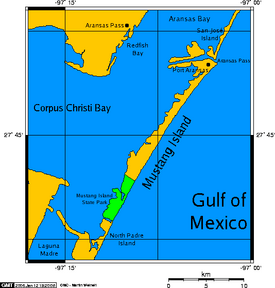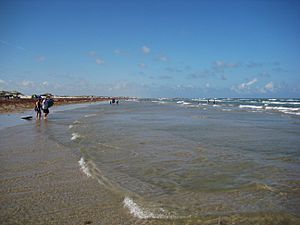Mustang Island facts for kids

Map showing Mustang Island, in a long chain of barrier islands (see: Padre Island, to the south).
|
|
| Geography | |
|---|---|
| Location | Gulf of Mexico |
| Length | 18 mi (29 km) |
| Highest elevation | 3 ft (0.9 m) |
| Administration | |
|
United States
|
|
| State | Texas |
| County | Nueces |
Mustang Island is a long, narrow barrier island located on the Gulf Coast of Texas, in the United States. It stretches about 18 miles (29 km) from the city of Corpus Christi to Port Aransas. The island faces the Gulf of Mexico on its east and south sides. To its north and west is Corpus Christi Bay.
Mustang Island is connected by road to Padre Island at its southern end. At the northern tip of the island is the town of Port Aransas. Beyond Port Aransas lies San José Island. A waterway called the Aransas Channel, or "Aransas Pass," separates Mustang Island from San José Island. This channel is protected by jetties that reach into the Gulf.
The town of Port Aransas is found at the northern end of Mustang Island. A large part of the island, the southern third, is home to Mustang Island State Park. This park covers 3,955 acres (1,600 ha) and includes 5 miles (8 km) of beautiful beach. The city of Corpus Christi also includes a part of Mustang Island, located between Port Aransas and the state park.
Mustang Island is a very popular spot for visitors. Many students come here for Spring Break because of its sandy beaches. It's also a favorite place for "snowbirds" – people from colder northern areas who like to spend their winters in warm places.
Island History: From Wild Horses to Settlers
Mustang Island has a long history, dating back to the time of Paleo-Indians. In 1519, a Spanish explorer named Alonso Álvarez de Pineda sailed through the pass near the island. He later named the nearby bay Corpus Christi Bay. At that time, the island was home to the Karankawa people.
By the 1700s, Spanish settlers had brought horses to the area. These horses roamed freely, and because of them, the island became known as "Wild Horse Island," which later changed to "Mustang Island." For many years, up until the 1840s, the island and its pass were used by various groups. These included buccaneers, Mexican smugglers, merchants, and immigrants. Some were looking for their own fortune, while others were after someone else's! The famous pirate Jean Lafitte was said to have visited Mustang Island and nearby islands in the 1820s.
During the Mexican–American War, a small fort was built on the island. Its purpose was to protect the entrance to Aransas Bay. The first settler to live on the island with his family was Captain Robert Mercer. His wife is believed to have been the first white woman in the area. Captain Mercer built a house there in 1853 and called it El Mar Rancho.
Amazing Island Wildlife
Mustang Island is an important place for many animals, especially sea creatures.
- Sea Turtles: In September 2007, wildlife experts found a record number of Kemp's ridley sea turtle nests on Texas beaches. This included 81 nests on North Padre Island and 4 nests on Mustang Island. That year, over 10,000 Kemp's ridley hatchlings were released along the Texas coast. These turtles are an endangered species. They face dangers from fishing nets and are sometimes hunted for their meat or shells.
- Whales: On June 10, 2008, a large sperm whale became stranded on one of the island's beaches. Sadly, the city did not have the right equipment to move such a huge animal. Because of this, the whale had to be euthanized to end its suffering.
Mustang Island from the Handbook of Texas Online
See also
 In Spanish: Isla Mustang para niños
In Spanish: Isla Mustang para niños


